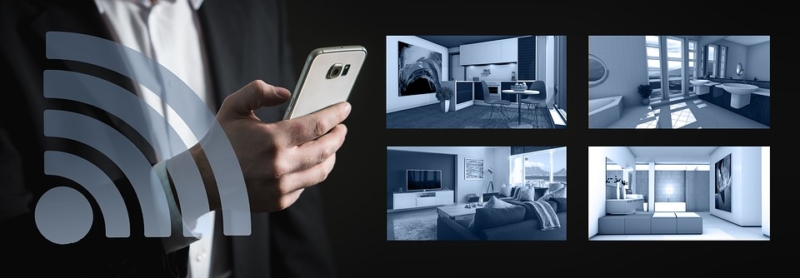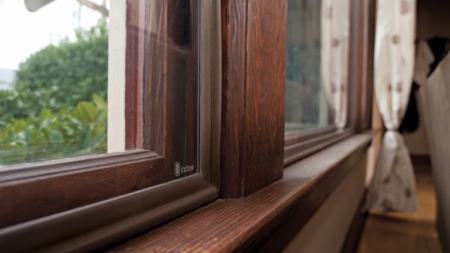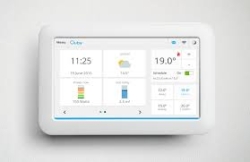Home security is often a concern for anyone who rents or owns a dwelling, whether it be someone who wants to ensure their pets are safe at home while out and about or someone who travels frequently for work or someone who desires peace of mind about home safety. There are different types of security systems depending on the needs of the home dwellers.
- Basic Home Security – If you want something simple or are just getting started, something like a single sensor alarm is an option. A magnet is installed onto a main entry door or window with a sensor and tiny alarm unit within the vicinity. A loud alarm is triggered when the magnetic field is breached.
- Intermediate Home Security – Dial-out security systems use an emergency dialer system to send an alert to your smartphone or another contact, such as a family member or a professional security company. These systems can also include smoke, temperature, and flood sensors. Installation is fairly simple and straightforward.
-
Advanced Smart Home Security – “Smart technology” utilizes WiFi network connectivity to monitor and control home security devices from a smartphone. There are a variety of options, such as sensors, surveillance cameras, motion detectors, floodlights, and alarms.
Smart home security options
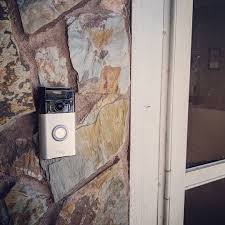
Doorbell camera
Doorbell Cameras – A video doorbell camera, such as the Ring system, that lets you see who is at the front door in real-time without having to get up and sneak a peek out the window. You can even see who is at the door while traveling out of town, plus you can communicate with them. Some doorbell cameras use easy to install battery-powered units and others use the wiring that is already in place for the doorbell. Some doorbell cameras can be connected to Amazon’s Alexa or another digital voice assistant.
Outdoor Cameras – An outdoor camera, such as Arlo Pro, can alert you to who is wandering around outside the home, such as in the garden or near the garage. The base station acts as a hub and the weatherproof cameras with rechargeable batteries can be installed wherever that needs monitoring. You can view all video footage and control an audible alarm from your smart phone as well as connect to a digital voice assistant.
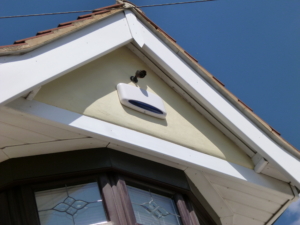
Outdoor security camera
Floodlighting – Motion-controlled floodlighting can be installed as a standalone system or used to add additional security when paired with a camera system. Floodlighting triggers bright lights and an audible alarm when detecting movement in the area of your choice, such as the driveway or backyard. For example, Ring has a Floodlight Cam that uses the same smartphone app as the video doorbell camera and can connect to Alexa. It has a wide coverage area offering a 270 degree field of vision. The app will alert you when the motion sensors are triggered, plus allow two-way communication with whomever triggered the alarm.
Motion Sensors – Modern day motion sensors use passive infrared (PIR) to detect moving objects within the protective grid, thus triggering an alarm.
-
Indoor Motion Sensors have the benefit of saving on electricity because indoor lighting becomes dependent on motion. If someone has a habit of forgetting to turn off the lights when they leave the room or home, the lights will go off automatically. The lights can also activate in the middle of the night when getting up for a drink of water, so no more stumbling in the dark or fumbling for a flashlight. Some motion sensors, such as SkyLink, add convenience, such as using the controller to dim or brighten lights, activate/deactivate alarm systems, control electrical appliances, draw up/down curtains, control a home audio system, and open/close a garage door. Rolling code technology helps to minimize chances of security breaches.
-
Outdoor Motion Sensors without floodlights are usually paired with security cameras. Outdoor motion sensors should be weatherproof and ideally cross-zoned to prevent false alarms when a squirrel scurries nearby. A system, such as Optex, gives a wide detection range while only sounding an alarm when two zones are triggered. Some offer an add-on option for anti-masking technology which prevents the sensor from being disabled from a spray or being covered.
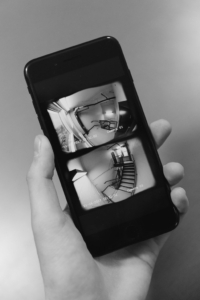
Security cam access from a smartphone
Indoor Camera – This system lets you view the inside of your home while away, whether it just be while out on a walk or on a long business trip. Most, such as Nest, let you connect to your digital assistant, such as Alexa. Some camera systems let you use your smart phone to have two-way audio communication with pets or people in your home while out and about. Most indoor cameras connect using WiFi while some use Zigbee or Z-Wave. Some indoor camera systems can be self-monitored while others have a subscription fee.
Door Locks – Smart door locks offer convenience, such as being able to enter the home with an armful of groceries and no need to fumble with keys. Ability to lock the door using the app can prevent wondering if the door was locked or not before leaving for work. Some smart locks, such as August Smart Lock, attaches easily to existing deadbolts so there is no expense of installation nor hassle of removing pre-existing locks. An additional feature of some smart locks is the ability to grant time parameters on granted access, such as for houseguests. You can use WiFi, Bluetooth, or Z-Wave to connect smart locks with a smart device. Bluetooth is the only communication protocol that doesn’t require a hub.
Alarm System – Most modern alarm systems give you the option to use Alexa or another digital assistant to communicate. IFTTT devices are often supported. You can buy your own kit, such as the Skylink SC-1001 Complete Kit Wireless Alarm System, and install everything at home or call a professional. Installing your own alarm system saves on installation charges and ongoing subscription fees. Some systems, such as the Skylink, can dial out to multiple phone numbers to inform about a security breach. Professional installations, on the other hand, involve more monetary investment including installation charges and a monthly subscription fee. This option can save time and hassle though, plus monitoring 24 hours a day by professionals. Security professionals contact the local fire and police departments when alarms are triggered. If you opt for a professional installation, there may be a contract with termination fee, so read the details and make sure you are comfortable before signing anything. Some options, like Abode, offer both options: A do-it-yourself kit with self-monitoring as well as HelloTech pro installation with professional monitoring.
Last, but not least, for additional security, consider the non-technical, but tried-and-true method of becoming somewhat acquainted with your neighbors. Familiarity can encourage neighborhood residents to look out for one another. For example, a resident might be outside checking the mail and notice someone unfamiliar trying to pry a neighbor’s window open or driving around slowly while only stopping at homes with delivered packages outside.

Smartphone = security system controller
Which smart device or system is better? It depends a lot on individual needs. Some people are quite content with just a doorbell camera, for example, while others prefer to have multiple layers of security, especially if there is concern for a security breach or frequent time spent away from the home. With today’s smart technology, home security is made easier and more accessible with being able to use a smartphone, tablet, or digital voice assistant as a controller.
Resources
https://www.safety.com/diy-home-security-guide/
https://www.pcmag.com/roundup/341490/the-best-smart-home-security-systems
https://www.safety.com/best-home-security-systems/
https://ifttt.com/ – What is IFTTT? IFTTT, also known as If This Then That, is a free web-based service to create chains of simple conditional statements.

